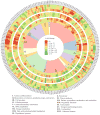Impact of growth mode, phase, and rate on the metabolic state of the extremely thermophilic archaeon Pyrococcus furiosus
- PMID: 28840937
- PMCID: PMC5809124
- DOI: 10.1002/bit.26408
Impact of growth mode, phase, and rate on the metabolic state of the extremely thermophilic archaeon Pyrococcus furiosus
Abstract
The archaeon Pyrococcus furiosus is emerging as a metabolic engineering platform for production of fuels and chemicals, such that more must be known about this organism's characteristics in bioprocessing contexts. Its ability to grow at temperatures from 70 to greater than 100°C and thereby avoid contamination, offers the opportunity for long duration, continuous bioprocesses as an alternative to batch systems. Toward that end, we analyzed the transcriptome of P. furiosus to reveal its metabolic state during different growth modes that are relevant to bioprocessing. As cells progressed from exponential to stationary phase in batch cultures, genes involved in biosynthetic pathways important to replacing diminishing supplies of key nutrients and genes responsible for the onset of stress responses were up-regulated. In contrast, during continuous culture, the progression to higher dilution rates down-regulated many biosynthetic processes as nutrient supplies were increased. Most interesting was the contrast between batch exponential phase and continuous culture at comparable growth rates (∼0.4 hr-1 ), where over 200 genes were differentially transcribed, indicating among other things, N-limitation in the chemostat and the onset of oxidative stress. The results here suggest that cellular processes involved in carbon and electron flux in P. furiosus were significantly impacted by growth mode, phase and rate, factors that need to be taken into account when developing successful metabolic engineering strategies.
Keywords: Pyrococcus furiosus; continuous culture; growth phase; growth rate; hyperthermophiles; transcriptome.
© 2017 Wiley Periodicals, Inc.
Conflict of interest statement
The authors declare no conflicts of interest.
Figures

 ), and 0.45 hr−1 (▲). The arrow indicates the start of steady state (to); samples for transcriptional analysis were taken after 5 reactor volume changes. Numbers represent transcribed ORFs (≥ 2-fold) for comparisons between column and corresponding row. For example, 64 ORFs were up-regulated in ES phase (8 hours) compared to E phase (5 hours). Dark gray areas
), and 0.45 hr−1 (▲). The arrow indicates the start of steady state (to); samples for transcriptional analysis were taken after 5 reactor volume changes. Numbers represent transcribed ORFs (≥ 2-fold) for comparisons between column and corresponding row. For example, 64 ORFs were up-regulated in ES phase (8 hours) compared to E phase (5 hours). Dark gray areas
 represent comparisons from batch cultures. Light gray areas
represent comparisons from batch cultures. Light gray areas
 represent comparisons from continuous cultures. E: exponential phase; ES: early stationary phase;LS: late stationary phase
represent comparisons from continuous cultures. E: exponential phase; ES: early stationary phase;LS: late stationary phase
References
-
- Boer VM, de Winde JH, Pronk JT, Piper MD. The genome-wide transcriptional responses of Saccharomyces cerevisiae grown on glucose in aerobic chemostat cultures limited for carbon, nitrogen, phosphorus, or sulfur. J Biol Chem. 2003;278(5):3265–74. - PubMed
-
- Burton NP, Williams TD, Norris PR. A potential anti-oxidant protein in a ferrous iron-oxidizing Sulfolobus species. FEMS Microbiol Lett. 1995;134(1):91–5. - PubMed
Publication types
MeSH terms
Substances
Grants and funding
LinkOut - more resources
Full Text Sources
Other Literature Sources
Research Materials

